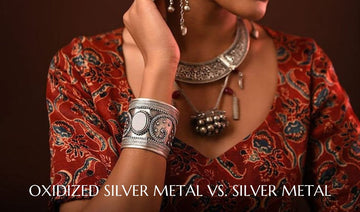In the realm of
jewelry and decorative items, silver metal holds a prestigious spot, cherished for its radiant sheen and elegance. However, within the spectrum of silver lies a fascinating variation that has captivated artisans and wearers alike:
oxidized silver. This article delves into the intriguing world of silver, drawing a clear line between oxidized silver metal and its unoxidized counterpart, while exploring the unique allure that each brings to the table.
Understanding Silver Metal:
Craftsmen and designers favor silver, a precious metal with a long history in jewelry, coins, and various decorative items, for its lustrous finish and malleability. They can sculpt it into intricate designs, celebrating its versatility and beauty. Its inherent beauty and the way it captures light make silver metal a timeless choice for creating pieces that exude elegance and sophistication.
The Oxidation Process: A Creative Embrace:
Oxidized silver, on the other hand, introduces an element of dramatic flair to the silver's natural beauty. Oxidation is a chemical process that occurs when
silver metal is exposed to oxygen in the presence of sulfur. This interaction forms a layer of silver sulfide on the surface, giving the metal a darkened appearance. Far from being an undesirable effect, skilled artisans deliberately induce oxidation on silver items to highlight textures, patterns, and details, adding depth and a vintage charm that is impossible to achieve with polished silver alone.
The Aesthetic Appeal:
The primary difference between oxidized silver metal and its gleaming counterpart lies in their aesthetic appeal. While
traditional silver metal shines with a mirror-like finish, oxidized silver boasts a matte, tarnished look that exudes an antique or rustic vibe. This contrast is not merely visual but also symbolic, with polished silver often associated with modernity and sophistication, whereas oxidized silver suggests a storied past and a connection to history and tradition.
Durability and Care:
When it comes to
durability, both forms of silver metal require proper care to maintain their beauty. Oxidized silver, however, has the added advantage of being more forgiving when it comes to scratches and fingerprints. The patina that develops over time can actually enhance the character of the piece, making it more appealing to those who appreciate a lived-in look. Conversely, silver metal in its pure, polished form is more prone to showing wear and requires regular polishing to keep its bright shine.
The Making Process:
The creation of oxidized silver jewelry involves a deliberate process of accelerating the natural
tarnishing process. Artisans often use mild solutions, such as liver of sulfur, to achieve an even and controlled darkening of the surface. This technique allows for precision in creating patterns and contrast, particularly in pieces where both oxidized and polished silver are used together to create striking visual effects.
Versatility in Design:
The versatility of silver metal, whether oxidized or polished, is unparalleled. Oxidized silver is often the material of choice for
bohemian, gothic, and vintage-inspired designs. Its darker tone provides a stunning backdrop for
gemstones, making their colors pop in a way that can be more subdued against the brightness of polished silver. On the other hand, the reflective quality of polished silver makes it ideal for creating pieces that are both elegant and minimalist, proving that silver can adapt to any style or preference.
Cultural & Symbolic Significance:
Beyond their aesthetic and physical differences, oxidized and polished silver carry distinct cultural and symbolic meanings. In many cultures, silver is associated with purity, clarity, and the moon's ethereal glow. Oxidized silver, with its aged appearance, often symbolizes resilience, longevity, and the beauty of aging gracefully. This duality presents a fascinating narrative where both forms of silver can represent different facets of life and artistry.
Sustainability & Ethical Considerations:
In recent years, the jewelry industry has faced increased scrutiny regarding
sustainability and ethical sourcing. Silver metal, in both its oxidized and polished forms, is not exempt from these concerns. Ethically sourced silver and practices that minimize environmental impact are becoming more important to consumers. In response, artisans and manufacturers adopt more sustainable methods, recycling old silver pieces and ensuring the responsible sourcing of new silver.
Conclusion:
The choice between oxidized silver metal and polished silver metal is more than a matter of preference; it's a reflection of personal style, values, and the story one wishes to tell through their adornments. Both forms of silver offer unique benefits and aesthetic appeals, making silver metal a versatile and cherished material in the world of jewelry and beyond. Whether drawn to the bright reflectiveness of polished silver or the textured depth of oxidized silver, enthusiasts can revel in the knowledge that their choice contributes to a rich tradition of
craftsmanship and beauty.
In embracing the diverse expressions of silver metal, we find a material that is both timeless and adaptable, capable of capturing the essence of human creativity and the endless possibilities that come with it. Whether for its beauty, its cultural significance, or its ability to convey personal meaning, silver metal, in all its forms, remains a cherished element in the art of jewelry making and beyond.





